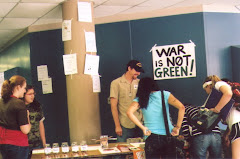Army Reserve Captain LeRoy Torres will never forget the 10-acre plot of land, full of burning garbage, located about a mile from his sleeping quarters at Balad Air Base in Iraq. The year was 2008.
All the military’s waste was thrown into the pit, doused with a jet fuel known as JP-8, and set on fire.
“You’d see tires, plastics, batteries. Large bottles and containers of fluid, no telling what it was,” Torres said. “Solvents. Medical waste. You’d see those red medical bags from the hospital just being tossed in the fire.”
Staff Sergeant Jeremy Daniels arrived at Balad in 2005. He remembers seeing items destined for the flames.
“It doesn’t matter if it comes out your room, if it comes off your body, if it comes out your body. Go down there and light it ablaze.”
At the height of its activity, the Balad pit burned about 200 tons of trash each day.
The smoke it gave off was overwhelming, especially when the wind blew a certain way. It stuck to people’s clothes, filled their lungs, and got in their eyes.
“It was a cloud. You wore it,” he said. “If you walked around on that post, you smelled like it. It is the most horrid sulfuric smell you have ever frickin' smelled.”
LeRoy Torres agrees. “There were times—I remember one time clearly—I couldn’t even see the road 6 feet in front of me,” he said.
Soon after they arrived at Balad, both Torres and Daniels got sick. Torres started coughing up a black mucus that military doctors called ‘Iraqi Crud.’ It was the result, they said, of his body getting used to the environment in-country.
Daniels developed a weeping rash on his lower extremities that didn’t resolve for months. The skin sloughed off and bled. Doctors suggested that he was allergic to his laundry soap. Then he developed fourth nerve palsy, a neurological disorder that affects vision.
“While I’m walking to work, my left eye goes up and to the right while I'm still trying to look forward. I end up with the worst drunken double vision I've ever seen.”
After they returned home, the issues got worse. Torres’ respiratory problems were given a name: constrictive bronchiolitis, an untreatable and often fatal lung injury. Daniels' neurological problems were labeled ‘relapsing multiple sclerosis’ with an ‘extremely aggressive onset.' He now uses a wheelchair.
Both men were medically retired from their jobs. They both blame the burn pits for their health problems.
The use of open burn pits continued until 2009*. Hundreds of them were scattered across Iraq, Afghanistan, and Djibouti.
THE DISCONNECT
By the end of the decade, VA was grappling with an influx of disability claims related to toxic exposures from the burn pits. Kerry Baker was the Chief of Legislative and Policy Staff for V.A’s Compensation Service at the time. He now works as a VA appellate practitioner.
“Because the claims being filed by veterans for disability related to those burn pits and other exposures were increasing, V.A. had to come to terms that they didn’t have any real policy instruction for thousands of adjudicators out in the field for how to process those claims.”
To fix that, Baker helped publish a 2010 V.A. training letter on potential environmental hazard incidents, including burn pits.
The letter lists DoD air sampling results taken at Balad Air Base in 2007. A swathe of carcinogenic chemicals and dioxins were released as byproducts of burning trash. One of them is similar to Agent Orange, the defoliant that made soldiers sick in Vietnam.
Capt. Torres,’ wife, Rosie, has a copy. She brings it along to all of her husband’s doctors’ appointments.
“You can go to the VA and they’re like, ‘What are you talking about? Burn pits?’ So when you take this letter to a doctor at the VA, they don’t know what you’re talking about. Not even the environmental coordinators know what you’re talking about.”
Kerry Baker thinks that’s disappointing, since the letter was incorporated into the VA’s claims operating manual.
“That tells me that beyond that letter, the VA has not done anything since to really educate its people on the subject," he said.
The VA’s official stance on burn pit exposures is blunt: “At this time,” it says, “
research does not show evidence of long-term health problems from exposure to burn pits.”
But research in this area is challenging. Given that so many different items were burned in so many different places, creating a framework for studying the burn pits has been all but impossible. A
study by the Government Accountability Office last year found that the Department of Defense “needs to fully assess health effects” of open burn pits.
The VA currently administers a
national burn pit registry where veterans can fill out a questionnaire to report exposures to airborne hazards. However, veterans often do not complete the survey. It also does not permit death entries.
Add to that the problem of other exposures that soldiers face: sand and dust naturally present in the air, pollution, IED explosions, fires.
That cone of uncertainty has a cost. Many veterans struggle to document their exposures in a way that’s sufficient to get VA compensation. Some vets are told that their symptoms are psychosomatic, or the result of milder conditions.
Jeremy Daniels believes that this amounts to systemic denial.
“I'm not a doctor, but I'm going to say that the Army and the VA want to create their own narrative as to what's wrong with people,” he said.
SETBACKS AND STEPS FORWARD
2017 has been a year of setbacks for those who suffered as a result of the burn pits. The Texas legislature
failed to pass a bill that would have created a burn pit registry to collect health data and provide affected veterans with a way to connect with one another. The bill was opposed by a group called Texans for Lawsuit Reform, which expressed concern that a public registry would be used as a tool for class action lawyers to recruit new clients.
In July, a federal judge dismissed a class action lawsuit against Kellogg Brown and Root, the Houston-based contractor in charge of the burn pit at Balad. He said that the company acted on behalf of the U.S. military, and couldn’t be held liable for soldiers’ illnesses.
Capt. LeRoy Torres was part of that lawsuit. His wife Rosie said that he’s barely talked about the defeat.
“Just because he's gone through such a tough time losing his career already, I didn't want to spend time asking. Because I know that for a lot of veterans like LeRoy, it's just another step in the wrong direction. Another reason for them to become hopeless.”
Veterans and their families are growing desperate for accountability. Rosie Torres says that if Kellogg Brown and Root isn’t held responsible, the government needs to pick up the slack.
“If they're not gonna hold them [KBR] accountable, then the federal government should step up and take care of these soldiers that are dying. Take care of them, take care of the gold star families, their widows, their children that are being denied benefits time after time after time,” she said.
The Torres family have funneled their frustrations into a nonprofit called
Burn Pits 360, which acts as a source of information and support for vets. Burn Pits 360 went before Congress earlier this year to spread awareness about the issue.
Texas Congressman Joaquin Castro has helped in their cause, co-sponsoring the
Helping Veterans Exposed to Burn Pits Act, which would create a VA Center of Excellence in the prevention, diagnosis, mitigation, treatment, and rehabilitation of health conditions related to burn pit exposure. On Oct. 26, Rep. Castro requested a Congressional hearing on the issue.
“I really believe, after looking at everything that this could be the equivalent of Agent Orange in Vietnam. Where, for a while, people were ignored or not believed even though they were exhibiting symptoms,” Rep. Castro said in an interview.
Despite these glimmers of progress, Staff Sgt. Jeremy Daniels said he feels discouraged. He has traveled widely over the last year, seeking out different VA hospitals and trying to get the support of political advocates.
“Nobody wants to listen,” he explained. “I've called the White House. I called our Governor. I called two different Congressmen here in Texas. Because with all these people coming home and getting sick… They have to own up to what the hell they've done to us.”
*Although open burn pits were officially discontinued in 2009, there have been allegations of their use since.

















